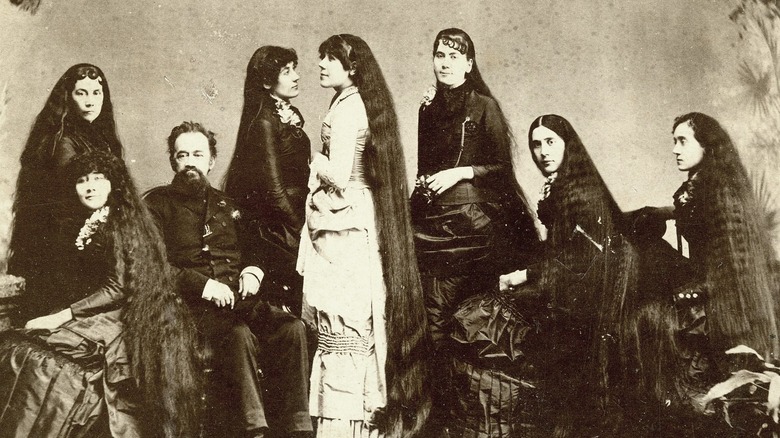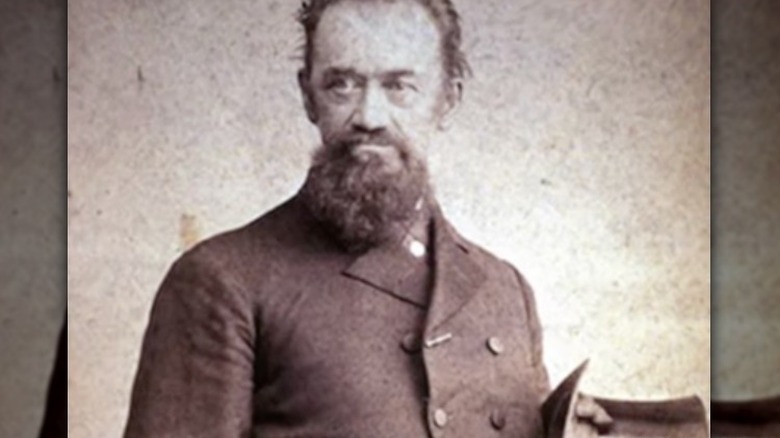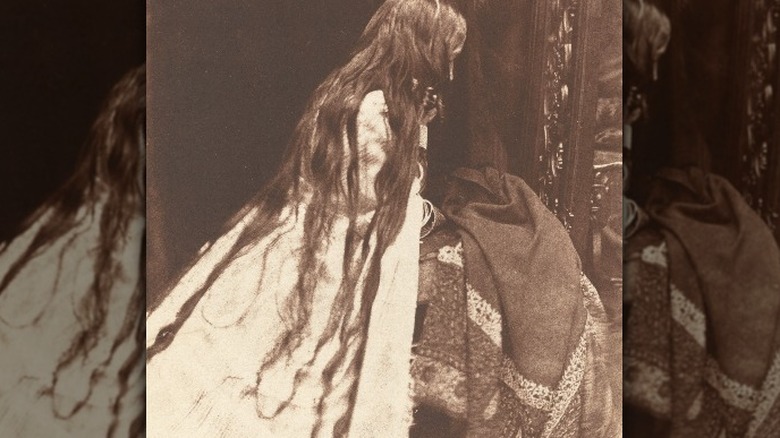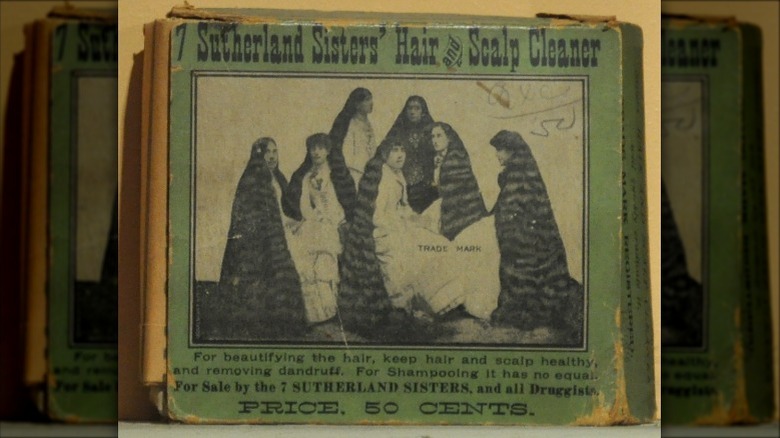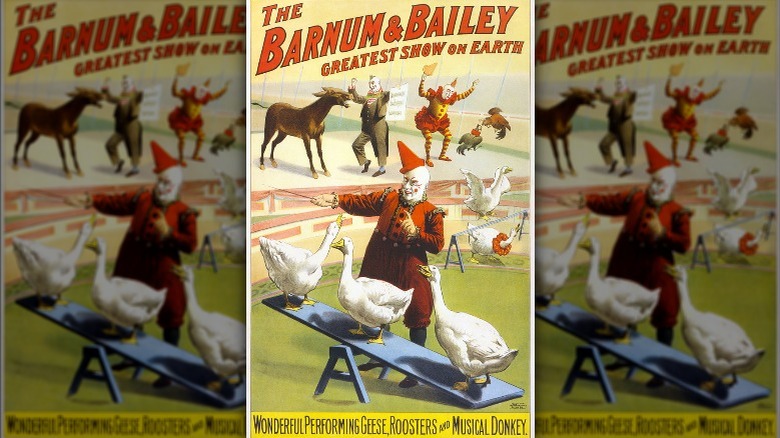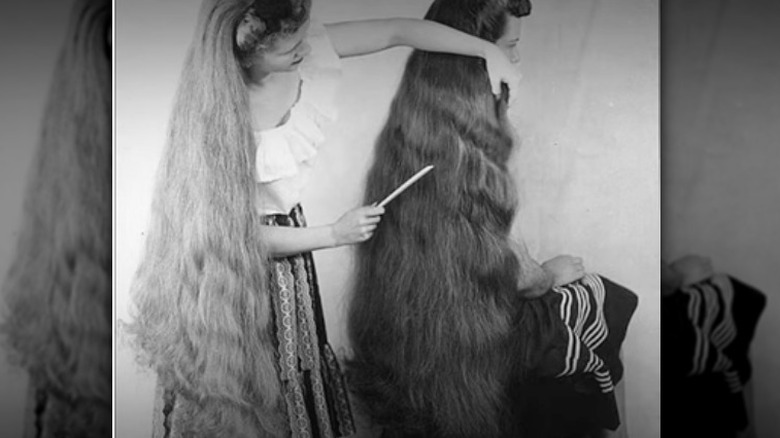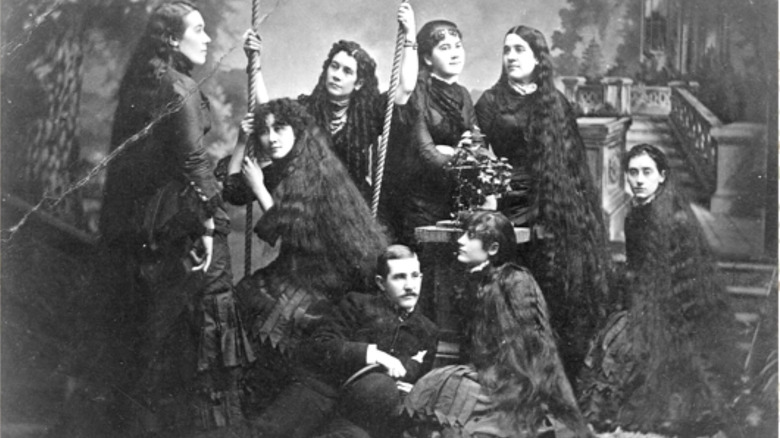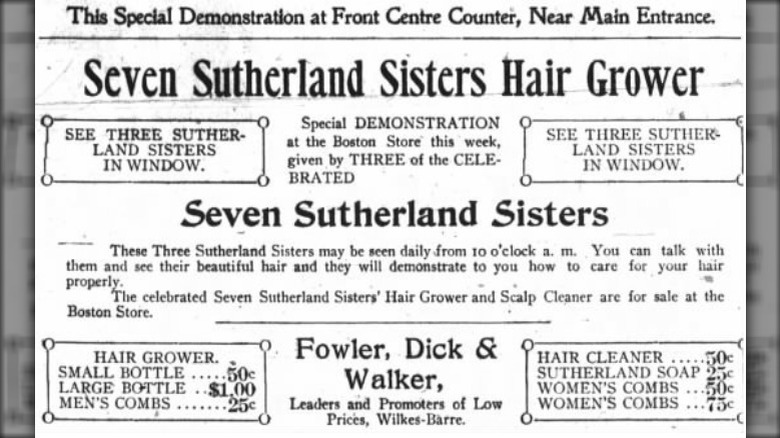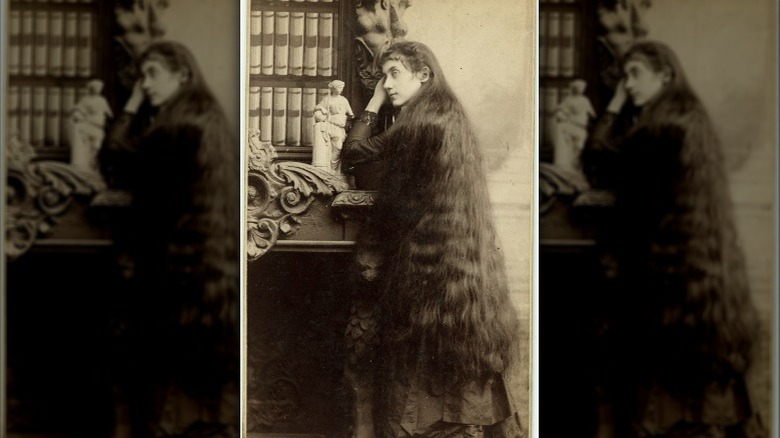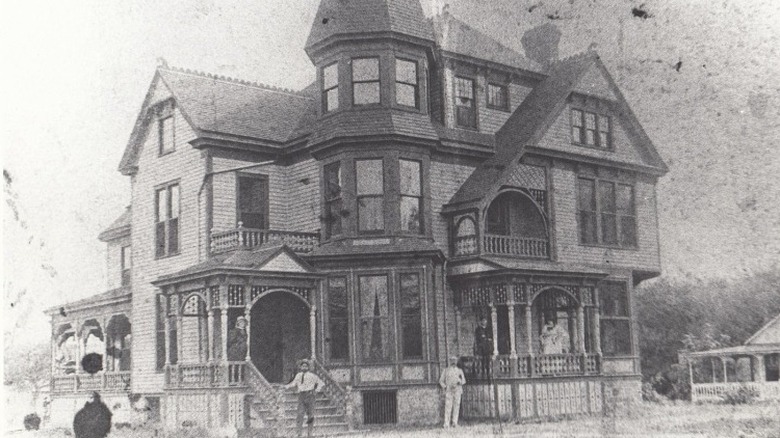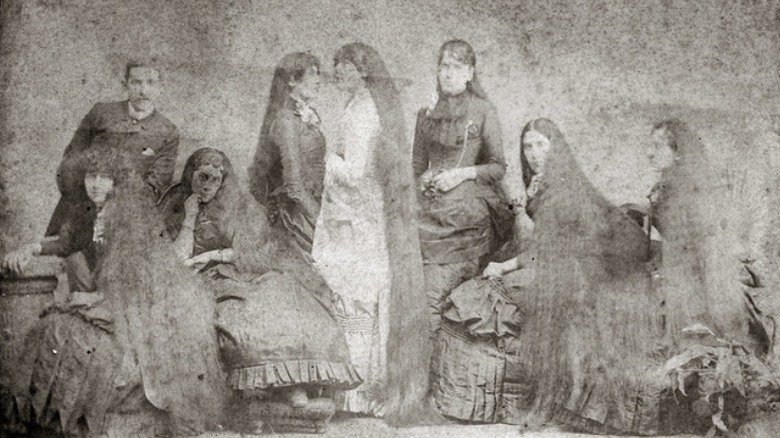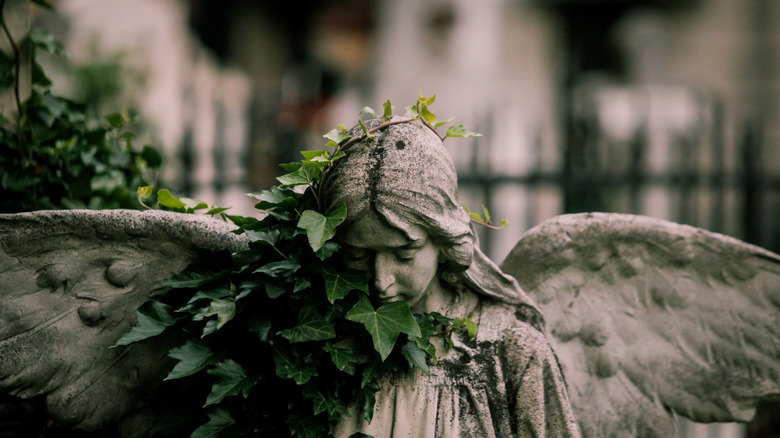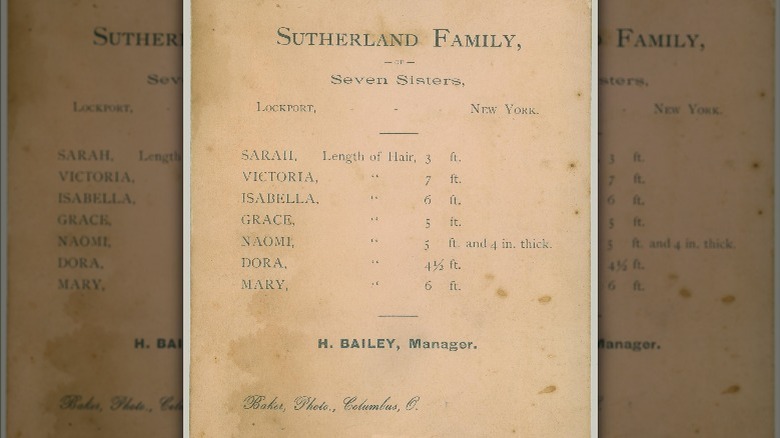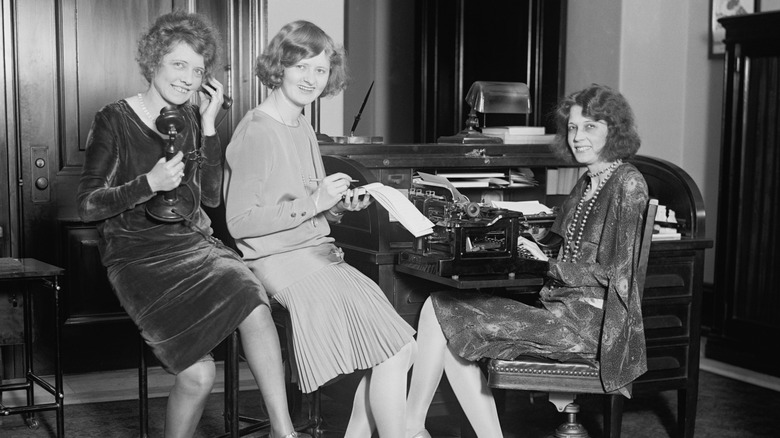The True Story Of The Seven Sutherland Sisters And Their 37 Feet Of Hair
The story of the Seven Sutherland sisters is filled with twists, turns, and plenty of entanglements (via History of Yesterday). But, of course, what would you expect from entertainers who boasted 49 glorious feet of hair, according to promo posters of the day? (Ripley's reports the combined total as a mere 37 feet of flowing tresses.) The 19th-century equivalent of commercial models, the girls captured the imaginations and the hearts of the thronging audiences they entertained with their musical talents and Rapunzel-like good looks.
They milked their hair-growing expertise for every penny they could get in the process. Their incredible story and its tragic finale started and ended on a small Niagara County, New York farm where Sarah, Victoria, Isabella, Grace, Naomi, Dora, and Mary enjoyed a humble childhood. Each night, their mother, Mary Brink Sutherland, slathered their locks in a stinky solution she claimed promoted hair growth and quality.
While the verdict's still out on whether the smelly concoction did the trick, one thing was for sure. The Sutherlands girls knew how to cultivate hair and plenty of it. Not only did each one grow a set of locks stretching between three and seven feet long, but their hair proved luxuriously thick, too. Reports say it came in at four inches from the scalp to the crown. Billed as "the most costly curiosities" (via Atlas Obscura), here's their remarkable true story.
They were the seven Cinderellas of 19th-century New York
Whether we're talking "Maid in Manhattan," "Pretty Woman," or even "Aladdin," we're all suckers for a good, old-fashioned rags-to-riches story. In fact, social psychologists argue we're hardwired to love stories involving sacrifice and struggle that culminate in a happy ending. This theme proves as old as civilization itself, per Inc.
When it came to the Sutherland sisters, they gave the world seven rags-to-riches stories that the nation could get behind, as reported by the Buffalo News. Considering their humble beginnings on a turkey farm in Cambria, New York, no one would've guessed the great fame the timid girls with their thick braids would one day attain. Due to the poverty imposed on them by their do-nothing dad, Fletcher Sutherland, the girls wore old, ill-fitting clothes. They often went barefoot while completing farm chores. Atlas Obscura explains that Fletcher dabbled at being a minister, avoiding the menial labor he relegated to his wife and children.
The transformation from muddy-footed farm girls to the nation's first celebrity models would prove fascinating (via their biographer Brandon Stickney, writing for Sideshow World). But though they'd eventually live in the lap of luxury, owning a highly successful company and savoring mansion living, their fates remained fettered by their lazy father, who never hesitated to exploit them for financial gain.
A hair tonic brought long locks and social rejection
Mary Brink Sutherland doused her seven daughters' curls with a one-of-a-kind hair tonic each night, per Atlas Obscura. But it left the girls in a quandary. While they might have nice hair, the ointment had a horrible odor that led to them being picked on in school. According to New England Today Living, between the hair tonic and their shabby clothes and bare feet, the Sutherlands were shunned from Niagara County society at large.
When Mary Brink Sutherland died in 1867, the original recipe for the nasty-smelling ointment went with her. Their aunt, Martha Brink, stepped in to care for her sister's children. Unlike Mary, though, Martha didn't have any secret hair tonic recipes. Despite the loss of this knowledge, it didn't stop Fletcher Sutherland from re-creating the formula and then using his daughters' act to market it to the public. One look at their flowing locks could convince anybody that the stuff they sold did the trick.
How the girls got their massive manes likely has more to do with genetics than anything else, as explored in P. S. Porter's "The Genetics of Human Hair Growth." But the 19th-century understanding of genetics remained in its infancy, as reported by Britannica. As a result, the Sutherland sisters would eventually capitalize on their hair products to rise to greater fame and financial standing. Ironically, these products followed in the footsteps of the hated hair tonic, which their mother had slathered on their glorious manes.
The Sutherland Sisters had a stage dad
Cliches abound about the horrors of having a pushy stage mom, but the Sutherland girls had to watch out for their dad, Fletcher Sutherland (via History of Yesterday). Somewhere along the way, he decided to exploit his daughters and son, starting with performances at local churches and community gatherings that highlighted their singing skills, as reported by Brandon Stickney.
As the Sutherland kids paraded across an increasing number of stages, they developed a wider repertoire of talents, which included musical instruments, per Atlas Obscura. Soon, they performed at local venues ranging from theaters to fairs billed as the "Sutherland Concert of Seven Sisters, and One Brother." They graced the stages of Buffalo, Rochester, and Broadway, following in their father's bombastic footprints as entertainers and storytellers par excellence. (Their brother Charles would eventually vanish from the act, which makes sense as he didn't have the gorgeous head of hair to fall back on.) The Sutherland sisters gained reputations as the world's most eligible bachelorettes, skilled in the musical arts and gifted with Rapunzel-esque locks.
After touring New York City, Atlas Obscura reports that the Sutherland sisters moved on to the South, the highlight of their tour being appearances at the 1881 Atlanta's International Cotton Exposition and World's Fair. Two years later, they headlined in Mexico with the W.W. Cole Circus, but the coup de grace was signing with the Barnum and Bailey Circus (via New England Today Living).
Barnum and Bailey signed the Sutherland Sisters
Barnum and Bailey Circus signed the Sutherland sisters in 1882, impressed by their lovely harmonies, instrumental talent, and especially their incredible lengths of untrammeled hair (via New England Today Living.) The girls ranged in age from 18 to 36 years old, and they wore all white during shows. Despite their varied talents, including Naomi's unique bass voice, the highlight of the show came when the girls let down their hair, according to Atlas Obscura.
The Sutherland sisters soon represented the ultimate "it" girls, as reported by Brandon Stickney. Think of them as the 19th-century version of the Spice Girls, only more modestly dressed. It's little wonder that P. T. Barnum, the greatest showman on Earth, had to sign them. The Sutherland sisters soon dominated photographs, newspaper clippings, and circus souvenirs. They reigned over sideshow memorabilia, books, cabinet cards, and postcards. Everyone wanted to keep a little piece of the sisters with them.
The Sutherland sisters navigated a fine line between respectability and membership in the sideshow universe as they embraced the circus life. This world got divided into three basic categories. They included people with congenital conditions known as "born freaks." Then, there were the novelty performers such as snake-charmers and fire-eaters. But the Sutherlands belonged to another category: "made freaks." These individuals modified their appearance to gain attention, whether it be tattooed ladies or men with extra-long beards.
The hairy allure of the Seven Sisters
The Sutherland Sisters played on trends of the day to attract massive audiences, according to Atlas Obscura. Few characteristics better represented femininity than long, thick, luscious hair, considered a vital source of the feminine mystique. Everywhere you looked, pop culture celebrated flowing manes, from the artwork of Dante Gabriel Rossetti to the verses of W.B. Yeats.
Kathryn Colvin, writing for Mythlore, argues that Rossetti's interest in locks verged on a veritable fetish, something he likely shared with many other men in the 19th century. No wonder the Sutherland sisters represented such an irresistible draw. Brandon Stickney, their biographer, describes the sisters and their obsession-inducing locks: "They had hair magnetism; hair was their art, their source of power and eventual wealth." But men didn't have a monopoly on admiration for the sister act. Victorian women remained fascinated by their incredible dos and wanted to know how to achieve similar results.
Magazines of the day counseled women to let their tresses grow unfettered. For example, "The Englishwoman's Domestic Magazine" advocated for the longest hair possible, even associating it with women's health. The magazine also claimed that cutting hair was against the very nature of feminine beauty. In essence, Victorian women proved equally obsessed with the Sutherland sisters, although their motivations were somewhat different.
The Sutherland Sisters had sex appeal
While the Sutherland Sisters billed themselves as well-educated and respectable, their show had undeniable sex appeal (via Atlas Obscura). The sisters walked a very thin line between acceptable entertainment and scandalous exposure. After all, a small flash of skin could be a shameful and rebellious act in the Victorian era.
While long hair was highly prized, that didn't mean women flaunted it. Instead, they kept their hair under tight control, plaiting, winding, and curling it into lovely (and tamed) updos. Respectable women only let their hair down in private. So, the Sutherland sisters' show navigated tricky waters between the sensational and sensual as "the seven most pleasing wonders of the world," per Atlas Obscura. They performed parlor songs and hymns to up their respectability factor, and they chose the circuses they traveled with strategically. For example, in 1883, they toured with the Forepaugh and Sells Brothers Circus, which made a stop in the British Isles, entertaining Queen Victoria.
But despite the sweet songs more suited to a Sunday afternoon with the family than a circus, their hair remained the focal point of the show, as noted by New England Today Living. When the girls finally turned their backs to the audience, pulling out hairpins and loosening plaits, the "Niagra of curls" flowed, met by exclamations of delight and amazement and ear-shattering applause.
How hair product sales fit into the mix
In 1885, Naomi Sutherland married J. Henry Bailey, the nephew of P. T. Barnum, New England Today reports. From Fletcher Sutherland, Bailey took over management of the sisters' performances. But he saw a much bigger picture when it came to the girls and their appeal. He wanted to use their incredible popularity to fuel sales of beauty products. So, Bailey pushed the family to start selling a version of the hair tonic their mother, Mary Brink Sutherland, had once slathered on their hair nightly.
But they had a serious problem on their hands, according to Atlas Obscura. When Mary Brink Sutherland died, she took the secret recipe for her hair tonic to the grave. Nevertheless, Bailey and Fletcher Sutherland weren't about to let that small detail get in the way of significant beauty product sales. So, they took inspiration from other patented medicines and formulas of the day, soon developing a product that promised to transform its users into beauties with inordinate lengths of glossy hair.
The result of their endeavors was "The Lucky Number 7 Seven Sutherland Sisters Hair Grower" (a.k.a. "Hair Fertilizer"), which retailed for $1.20 for eight ounces or the equivalent of $30 today. The ingredients of the Hair Grower included quinine, bay rum, borax, salt, and powder derived from the Spanish Fly — a beetle that was thought to be an aphrodisiac. Their product flew off the shelf, followed by a Scalp Cleaner, a comb, and Hair Colorator in eight hues.
Making it rain with promises of luxurious hair
The Sutherland Sisters Corporation proved phenomenally successful, bringing in $90,000 in sales in the first year alone, according to Atlas Obscura. The brand soon boasted 28,000 dealers and offices from New York City to Chicago, Toronto to Havana. Before they knew it, the Sutherland sisters sold 2.5 million bottles of their Hair Grower, bringing in more than $3 million in revenue!
Ad campaigns kept the Sutherland sisters' glorious hair front and center as the brand made extraordinary, inflated promises. These advertisements played on the Victorian era's love for long hair. They also made weighty promises like curing alopecia, as seen in advertisements displayed on Hair Raising Stories. On each box of Hair Grower, customers found a portrait of the sisters with their locks flowing over their shoulders and down their backs, according to Brandon Stickney. There was also a portrait of Reverend Fletcher Sutherland to add an air of authority. The box included testimony from the sisters, reading, "To our patrons: The enclosed preparation is manufactured and used by ourselves, and we recommend it as the best in the world."
Soon, the sisters boasted a whole line of products, including anti-dandruff potions, scalp cleaners, and a Hair Colorator that came in gold blonde, ash blonde, light brown, medium brown, auburn, dark brown, chestnut, and black. It cost $1. Between the sisters' great hair, testimonials for their products, and aggressive ad campaigns, they soon dominated the haircare industry.
Money fueled the family's eccentricities
The sisters earned money hand over fist. They built a stately mansion where the family's turkey farm once stood, with all the latest amenities, according to Atlas Obscura. Each sister had her own bedroom, and the marble bathroom boasted running water — both hot and cold. It was furnished with the finest pieces of furniture imported from overseas, had woodwork in black walnut, and showcased hardwood floors that glittered with the lights of massive chandeliers overhead. If that weren't enough, the house even had a turret and dome where they could escape for a fantastic view and a little quiet time.
But the audacious nature of their spending didn't stop there. The sisters became increasingly eccentric the richer they got, per New England Today Living. They hoarded pets while giving them the royal treatment, which meant winter and summer wardrobes, obituaries in the newspaper, and grand funerals. Their pets ate only the finest cuts of chicken and beef, and they slept on silk beds. The sisters shod the horses that drew their carriage in gold. They even held gala socials culminating in fireworks and sometimes violence, notes Brandon Stickney.
The sisters also loved to ride their bicycles while wearing bathing garments. Perhaps most telling, Mary's room locked from the outside and had a slat in the door for food. She appeared to suffer from mental health issues, which some doctors blamed on her excessive mane.
Tragedy stalked the Sutherland family
Although the Sutherland sisters savored a level of luxury few people ever get to enjoy, they felt dogged by the alleged "Sutherland curse," as Brandon Stickney explains. The Sutherland Sisters lost their mother in 1867 when Mary, the youngest girl, was little more than a toddler. And they also came within inches of death during a blazing fire at a hotel in New Orleans. They likely chalked Mary's mental illness to the same curse, and the supposed ill fortune didn't stop there.
In 1893, Naomi died before reaching the age of 40 of cancer, leaving behind three children, the only heirs of the Sutherland family through Fletcher Sutherland's line. There was also a weird love triangle involving Isabella, her husband Frederick Castlemaine, and her sister Dora, per Atlas Obscura. According to New England Today, Castlemaine represented the perfect 19th-century bad boy, with his devil-may-care charm and handsome appearance. He also had an addiction to opium and morphine. It culminated when he took his own life while on tour with the ladies.
These tragedies appeared to make the sisters come unhinged. Because they had money to waste and nobody to counsel them otherwise, their strange behavior was amplified. In particular, they didn't deal well with death, which led to some downright macabre scenes.
They didn't deal well with death
The Sutherland Sisters must've secretly fantasized about immortality because they sure didn't understand the finality of death. According to New England Today, when their sister Naomi passed away, they kept her body at the mansion for weeks. Their excuse was the construction of a mausoleum with a hefty price tag of $30,000. But somewhere along the way, they became disenchanted with the whole endeavor and ultimately left their sister interred in the family cemetery without a headstone.
A similar problem emerged with the death of Frederick Castlemaine. They kept his body in a glass coffin in the mansion's music room for weeks, refusing to have the body moved or even embalmed. The sisters gathered daily around Castlemaine's decomposing corpse, singing to him. Eventually, the odor got so bad that the local health department had to step in. Officials compelled the women to move his body to a granite mausoleum costing $10,000.
But the weirdness didn't end there. Castlemaine's widow Isabella spent the next two years walking every night to the mausoleum (3 miles away) to sing to his body and commune with him. Eventually, the 46-year-old widow married Alonzo Swain, 30, and abandoned this practice. Because of their inability to accept their loved ones' final fates, locals started whispering about the goings-on at the Sutherland mansion. As reported by Brian Stickney, questions abounded about whether they conjured the dead, were adherents of spiritualism, or even communicated with demons.
Some Sutherland Sisters preferred much younger men
The Sutherland sisters inhabited a unique position in society as self-made millionaires, per Brandon Stickney. In a time when savvy business skills were recognized in men alone, the Sutherland sisters bucked convention. But as the money flowed in, it led to opportunistic suitors looking to capitalize on the women's free-flowing cash.
Perhaps that's why the women preferred not to marry at all or marry much younger men. According to New England Today, Frederick Castlemaine was 13 years younger than Isabella Sutherland when they wed. (After their marriage, rumors circulated about his continued pursuit of sister Dora.) And after his death, she eventually moved on with another much younger beau, Alonzo Swain. Although she may have rationalized that a younger man proved less of a threat to her wealth, fate proved her wrong. Swain talked Isabella into selling her shares in the Sutherland Sisters business and embarking on a new venture to promote a hair restorer. But the formula was awful, and sales tanked. Isabella died alone without a dime to her name while Swain vanished, presumably on another get-rich-quick escapade.
Despite the horrors she witnessed firsthand with Isabella's marriages, Victoria Sutherland eventually married, too. At the age of 50, she had a 19-year-old husband. The Sutherland sisters found the situation scandalous and censured Victoria for her nuptials. The rift would prove so significant that Victoria didn't even enjoy a deathbed visit from her sisters.
Flappers put them out of business
By the 1920s, rebellious young women made chopping their locks off trendy, according to History. Never had there been such an upheaval when it came to fashion trends, and it proved one the remaining Sutherland sisters were ill-prepared to counter. They watched their fame and wealth evaporate, living long enough to become sadly irrelevant. They were even called out in a New Yorker cartoon titled "Dream Girls of a Dim Decade," per Fine Art America.
Unfortunately, the Sutherland sisters squandered their wealth through bizarre antics and poor investments. As a growing number of women chopped their locks in favor of sassy, chin-length bobs, the money dried up (per Atlas Obscura). By 1931, the remaining Sutherland sisters abandoned the family mansion, no longer financially capable of supporting it. Sadly, a fire consumed the home (likely along with the recipe for their hair tonic) less than a decade later, in 1938.
Ironically, the Sutherland sisters had helped usher in a new age of female freedom, as reported by Brandon Stickney. After all, they were entrepreneurs in a time when women generally got relegated to marriage and babymaking. The Sutherland sisters also gained a reputation by bucking conventions throughout their lives. Yet, they remained blindsided by the shift from Rapunzel-length locks to neck-revealing flapper hairdos, which left them as impoverished as they'd come into the world. Their Cinderella story came to a tragic end.
